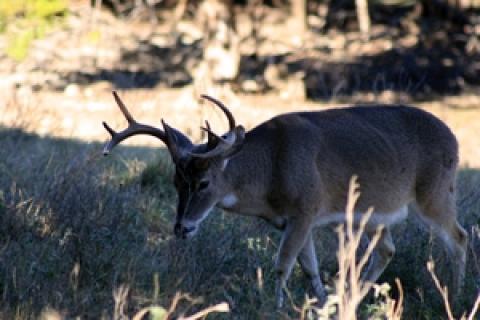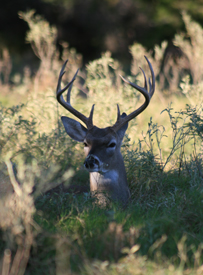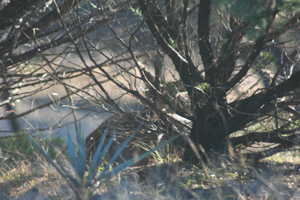
 Each year, more and more deer hunters are discovering that sometimes the best hunting strategy is to abandon the stand, get on the ground and go after your deer. Walk-and-stalk hunting can put a deer in your rifle sights if you follow the guidelines. Fail to adhere to the rules when walking up a buck, however, and you'll probably only see a white tail waving good-bye.
Each year, more and more deer hunters are discovering that sometimes the best hunting strategy is to abandon the stand, get on the ground and go after your deer. Walk-and-stalk hunting can put a deer in your rifle sights if you follow the guidelines. Fail to adhere to the rules when walking up a buck, however, and you'll probably only see a white tail waving good-bye.
Most deer hunters have nothing against tree stands and own and use several each season. The problem is that, after hours spent perched on a small platform, most hunters will feel the urge to move. If the deer aren't moving, then it's definitely time to go after them. Don't be fooled, however, into thinking you can simply walk along, spot and shoot a deer. Mother Nature gave deer keen defenses: a top camouflage coating of hair that blends in with the leafy forest to avoid your detection, big ears to hear your approach and eyes that can keenly spot your movement in all light conditions. To white-tailed deer, you are simply another predator in a long list that they've learned how to avoid.
If you are tired of waiting around in a stand, maybe you're ready for one of hunting's biggest challenges. The thrills and rewards are second to none in the hunting world when you get on the ground and hunt deer at their level and on their rules. When successful, you'll become a top predator in your hunting region. You'll also need to be prepared, alert, stealthy and quick before starting. Now start walking and get your deer.
Prepared for Success
Before your step out on your quest to walk up a buck, you'll need to prepare. In this situation, you're working to avoid detection by a deer's senses, so think about the things you'll need to do to overcome those keen detection systems. Your first obstacle is their hearing.
A deer's ear surface is roughly 4x8 inches, or 32 square inches of radar-like surface that can hear a twig snap at 100 yards on a calm day. Any unnatural noise instantly receives full attention and puts a deer on edge. Those ears can be overcome.
The first consideration is the boots you'll wear. While you'll want traction in rough and uneven terrain, you'll also need a less aggressive tread that permits you to walk in a near whisper mode. Some hunters like rubber knee boots and others like the boots with multiple "bobs" on the bottom. Boots designed for upland bird hunters can also permit more noise-free steps.
Next, rub the sleeve of any outer garment against your side. If you hear rustling or scratching, you'll need a wardrobe change. To whitetails, that subtle "scratch" of cloth against cloth means "hunter approaching." Fleece and similar soft fabrics mean hunter success when worn on the exterior. Should you have to don rain wear, be certain that it is also quiet when any surface-to-surface contact is made. Cordura, rough nylon and similar materials have their place, but trying to sneak up on a deer isn't one of them.
One other garment that should be studied, obtained and worn is gloves. Consider thin leather shooting gloves. They are durable, repel briars and permit instant firearm operation. Heavy insulated gloves can keep you from placing a finger inside the trigger guard and pulling the trigger. You have no time to pull a glove off your hand when a deer is near and alert. Gloves do, however, protect your hands when you have to push aside briars and brush to quietly walk through an area. Gloves also hide your hands, which often become flags alerting deer of your approach.
Before You Go
 |
| Look closely and you'll see this hidden deer. |
Since you'll be on the ground and needing to spot a whitetail before it spots you, you'll need to ratchet up the level of your observation powers. Obtain and use the best binoculars you can afford — period. Place the binoculars on a shoulder harness, and keep it handy and ready. Use it often. In fact, look more than you step.
Remember, binoculars are for spotting game, and this optical instrument is more comfortable to use than a single-barrel riflescope and much more "eye-opening" when used to scan and search. The golden rule in hunting optics is "you can't shoot what you can't see." Riflescopes are solely for shot placement and you severely limit your ability to spot game if that is your only optics. And then there's the safety issue of looking at someone through a riflescope in case that "object" seen moving morphs into a human. Avoid this situation.
Stealth Mode
When it's time to start moving on deer, think like a snail. They don't get there soon, but they get there. When you enter an area with deer around, you should plan to move slowly from point to nearby point. The last thing you'll want to do is walk like the average hunter and make that rhythmic "crunch, crunch, crunch" that means a hunter is walking.
You should move about 10 feet from tree to tree and bush to bush, or slowly down valleys and s-l-o-w-l-y up to ridge tops. You want to keep your body concealed while you peer over, around and beyond for a deer. Remember that bedded deer like to lay by logs, deep inside tall grasses or under bushes and rock ledges. You'll need to peer in with binoculars and also look for antler and ear tips. The object is to spot a buck before it spots you.
Another factor that can help you move close is bad weather. When heavy rains fall and whippy winds howl, most hunters dash for the cabin and a warm fireplace. Deer are still outdoors, and you should hunt them. Move slowly and use the noisy forest and field to hide your approach. Walk into the wind and also use it to your advantage. During brisk winds deer sometimes like to hide in cornfields, so go there and sneak from row to row and press your head between standing stalks to study lanes before you enter. Don't be surprised to see a deer. Also pause to study dense brush on windy days. Deer also like to crawl into the nastiest mess of brush they can find and hide inside, much like a rabbit. For the best view it is often necessary to kneel to peek under the brush. Use your binoculars again to peer in and inspect the brush well before you step near.
 |
| Deer like to lurk back in the brush; you'll need quality binoculars to peer in. |
Deer also like to bed on the side of ridges or near the tops (but not exactly on top) and look downhill, so walk from the top to the bottom of hills when possible. Before moving into place to shoot after spotting a deer, remember: where there's one there could be more, so scan carefully before you make that next move.
If you know where the deer trails and beds are in your hunting area, then move so you can observe them from the side and do not walk in trails. During the fall, and especially during the rut, deer will bed off a game trail but stay in a position where they can observe other deer possibly moving through the area.
As you move, your muscles generate heat. If you are sweating, you are moving too fast. Think slow and remember the snail. Dressing in layers can also help. Wearing the right camouflage pattern to match your surroundings can also be beneficial. Also, be honest with yourself about your hunting clothing. If your camouflage is a couple seasons old and faded so that it casts a mostly light — or bright — hue, it's time to make a new camouflage clothing purchase. Wearing a ball cap or hat with a brim over your face can also cast a shadow that hides your shiny face from an alert deer.
The odds of spotting and killing a deer are actually in your favor. Deer are plentiful, abundant and over-populated in many regions of North America. Your odds of spotting one are high if you'll only look ahead, study the terrain and move slowly.
When Not to Walk
The most important rule when walking up a buck is to be seen by other hunters. Wear blaze orange clothing and a cap so that you stand out in the dark forest. On private property, let other hunters in your party know you'll possibly be on the ground and hunting. Avoid areas where other hunters are hunting, and on most public lands this means not walking on the season's opening day. On public lands on other days, the safest times are often between 10 a.m. and 3 p.m. when most hunters have abandoned the woods and gone to restaurants. In fact, some of the largest bucks killed each season are shot near high noon.
Maybe it's time for you to start walking up a buck!
- 20774 views

